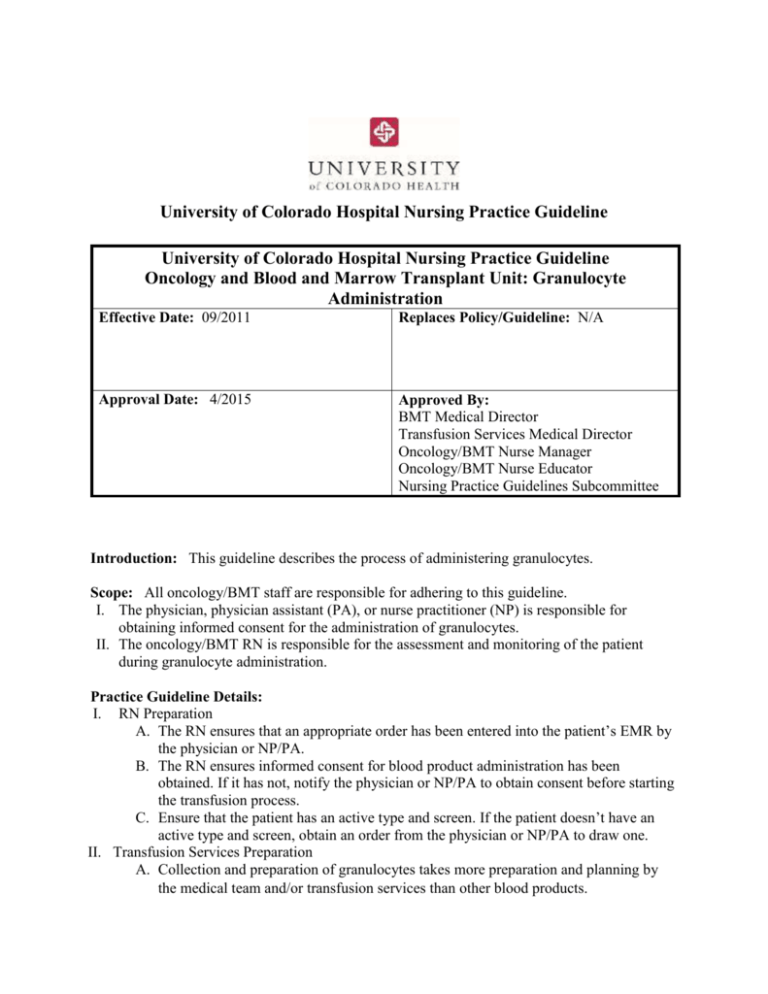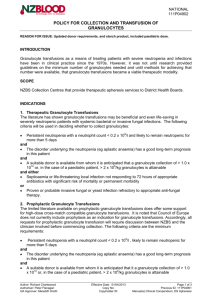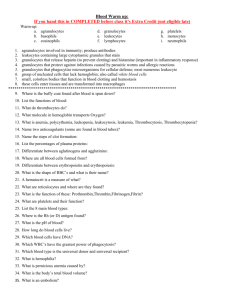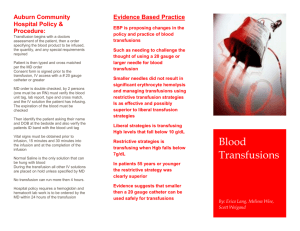File
advertisement

University of Colorado Hospital Nursing Practice Guideline University of Colorado Hospital Nursing Practice Guideline Oncology and Blood and Marrow Transplant Unit: Granulocyte Administration Effective Date: 09/2011 Replaces Policy/Guideline: N/A Approval Date: 4/2015 Approved By: BMT Medical Director Transfusion Services Medical Director Oncology/BMT Nurse Manager Oncology/BMT Nurse Educator Nursing Practice Guidelines Subcommittee Introduction: This guideline describes the process of administering granulocytes. Scope: All oncology/BMT staff are responsible for adhering to this guideline. I. The physician, physician assistant (PA), or nurse practitioner (NP) is responsible for obtaining informed consent for the administration of granulocytes. II. The oncology/BMT RN is responsible for the assessment and monitoring of the patient during granulocyte administration. Practice Guideline Details: I. RN Preparation A. The RN ensures that an appropriate order has been entered into the patient’s EMR by the physician or NP/PA. B. The RN ensures informed consent for blood product administration has been obtained. If it has not, notify the physician or NP/PA to obtain consent before starting the transfusion process. C. Ensure that the patient has an active type and screen. If the patient doesn’t have an active type and screen, obtain an order from the physician or NP/PA to draw one. II. Transfusion Services Preparation A. Collection and preparation of granulocytes takes more preparation and planning by the medical team and/or transfusion services than other blood products. III. IV. 1. Stimulated donations from friends or relatives have 2-5 times the number of granulocytes per unit compared to those collected from unstimulated donors. Stimulated collection is a complicated process that takes extensive monitoring and coordination. 2. Processes involved include: verification of donor ABO compatibility, stimulation of donor granulocyte production with corticosteroids and G-CSF, laboratory monitoring to check donor neutrophil count, and then leukapheresis for the collection of granulocytes. Finally, the product must be checked and prepared by transfusion services. B. Transfusion service contacts the RN when the granulocyte product is available. 1. Granulocytes must be transfused within 24 hours from the start of collection. 2. Granulocytes have a short survival time; they must be transfused as soon as they are available. 3. There is a higher potential for a transfusion reaction the longer the granulocytes are held before being transfused. C. Granulocytes may not be transported via the pneumatic tube system. The product is to be picked up at the blood bank by an oncology/BMT staff member or transporter with a valid ID as well as documentation of the patient’s name, medical record number, and requested blood product. Nursing Considerations Before Administration A. Do not administer amphotericin B within 6 hours of a granulocyte transfusion. Pulmonary insufficiency has been seen with the concurrent administration of amphotericin B and granulocytes. B. Granulocytes should always be irradiated. C. Granulocytes should be stored at room temperature; they should not feel cold upon receipt from the blood bank. Administration A. Premedicate the patient per physician/NP/PA orders. 1. Acetaminophen, antihistamine, steroids, and/or meperidine are often prescribed due to the increased incidence of pulmonary and/or febrile, nonhemolytic reactions associated with granulocyte transfusions. B. Verify patient identification at the bedside with another RN or physician/NP/PA. Compatibility testing for a granulocyte transfusion is the same as for a red blood cell transfusion, due to the number of red blood cells remaining in the collection bag. Follow the same identification process as for red blood cells. 1. Scan the patient. 2. Verify the patient’s name and medical record number on the transfusion tag matches the patient’s arm band. 3. Scan the granulocyte product. 4. Verify the patient’s blood type (recorded on the tag) is compatible with the donor type, written on the granulocyte product. If the patient has RBC antibodies, the donor should lack the corresponding antigen (for example, if the patient has anti-E antibody, the donor unit should be labeled as E negative). This is listed on the left side of the tag at the bottom of the printed information. Ensure the expiration date has not passed. 5. The administering RN and verifying RN/physician/NP/PA sign the EMR. V. C. Utilize standard Y-type blood administration set with 170-μm filter. DO NOT USE A MICROAGGREGATE FILTER. Set up the granulocyte infusion utilizing the same process as blood and platelet transfusions (as outlined in The Administration of Blood Components Policy). D. Using an infusion pump, infuse slowly, over 2-4 hours. E. Take the patient’s vital signs before starting the transfusion, within the first 15 minutes of starting the transfusion, and at the conclusion of the transfusion. F. Observe the patient closely for a transfusion reaction, including pulmonary symptoms such as cough, shortness of breath, increased respiratory rate, and fever or chills. 1. Notify physician/NP/PA if the patient experiences any of the above, and stop the granulocyte transfusion temporarily. Do NOT discard the granulocyte unit, unless the attending physician gives the order to do so. 2. Medicate with additional steroids or antihistamines per physician/NP/PA orders. Though it is not generally recommended to restart a transfusion if a patient has a reaction, the physician/NP/PA may order to resume the granulocyte transfusion once the patient recovers if it is a simple allergic reaction. 3. Order a transfusion reaction investigation and document the signs and symptoms of the reaction in the EMR. Nursing Documentation A. Complete pre-transfusion documentation in the blood product administration flowsheet in the EMR. B. Document the patient’s vital signs before starting the transfusion, within the first 15 minutes of starting the transfusion, and at the conclusion of the transfusion. C. Document the volume administered in the EMR. 1. The volume of granulocytes is located on the tag attached to the bag. D. Document completion of transfusion in the blood product administration and I/O flowsheets in the EMR. Related Policies and Nursing Practice Guidelines: Administration of Blood Components Consent for Medical Care and Procedures Hand Hygiene Refusal to Permit Blood or Blood Product Component Administration Definitions: Granulocytes are white blood cells, including neutrophils, basophils, and eosinophils. Granulocytes, specifically neutrophils, are crucial in protecting the body from and fighting bacterial and fungal infections. The use of granulocyte transfusions is generally reserved for the treatment of bacterial and fungal infections in patients with prolonged, severe neutropenia unresponsive to antibiotics and antifungal medications, namely hematopoietic stem cell transplant recipients or patients receiving any high dose chemotherapy that is expected to cause prolonged neutropenia. Granulocyte colony stimulating factors (G-CSF) are pharmacological agents that stimulate the bone marrow to produce granulocytes and release them into the bloodstream. Leukapheresis is the process of collecting granulocytes from donors by separating the granulocytes from other blood components using centrifugation. References: American Association of Blood Banks, America’s Blood Centers, American Red Cross, Armed Services Blood Program. (2013). Circular of Information for the Use of Human Blood and Blood Components. Retrieved from http://www.aabb.org/tm/coi/Documents/coi1113.pdf#search=granulocyte%20administration (LOE 8). Harris, D. (2009). The Resurgence of Granulocyte Transfusions. Journal of Infusion Nursing. 32(6), 323-329. (LOE 7). Gardner, A. (2014). White Blood Cell Granulocyte Transfusions: An Update. Neutropenia SIG Newsletter. Vol.12 (2). (LOE 8) Marfin, AM & Price, TH. (2015). Granulocyte Transfusion Therapy. Journal of Intensive Care Medicine. Vol. 30(2), 79-88. (LOE 7)










![CBS_Journal_Club_Oct4-2[1]](http://s2.studylib.net/store/data/010184017_1-be77cd1f047289dc9317c9ca9ab5c93b-300x300.png)